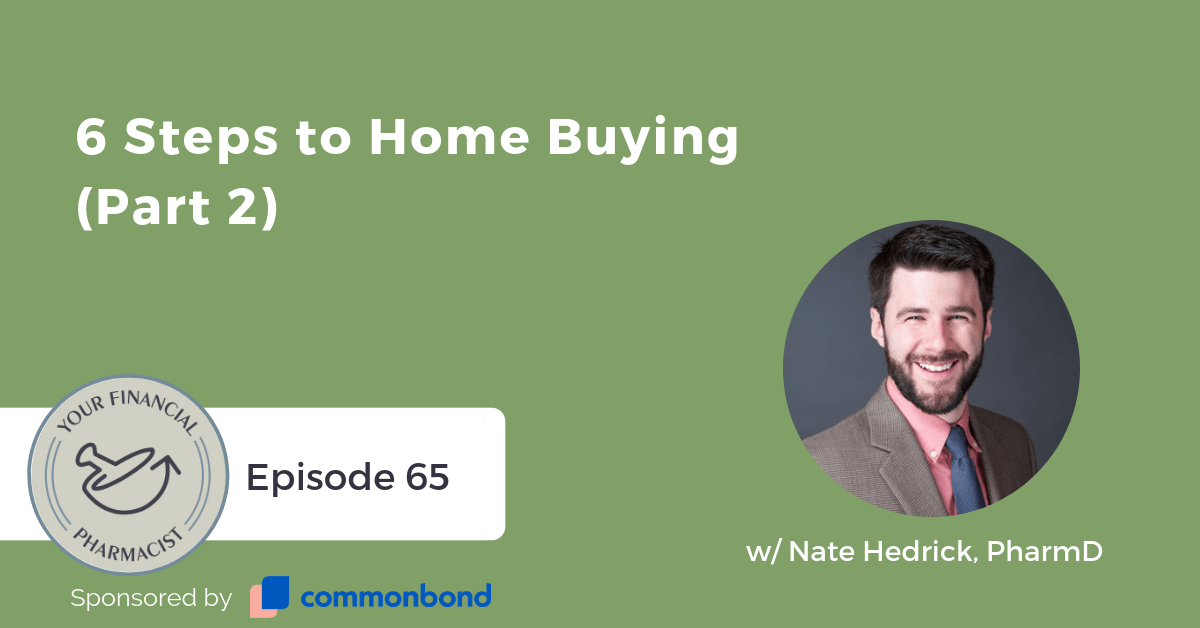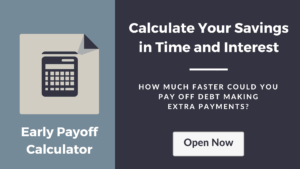6 Steps to Home Buying (Part 2)
On Episode 065 of the Your Financial Pharmacist Podcast, Tim Ulbrich is joined by Nate Hedrick, the Real Estate RPh, to continue a two part series covering the 6 steps to home buying every pharmacist should consider during this exciting process.
Summary of Episode
Nate Hedrick, pharmacist and licensed real estate agent, talks with Tim Ulbrich about the benefits of home buying for pharmacists and the last three of six steps to take when you are considering buying a home. As in Episode 064, these steps to home buying are found in the Home Buying Quick Start Guide.
Step four covers choosing a loan and getting pre-approved. Nate discusses the differences between being pre-qualified and pre-approved for a loan and dives into breaking down different types of housing loans available, such as Conventional, FHA, VA, and Doctor Loans. Step five is all about finding your home and negotiating. Depending on what type of housing market the house you are looking to buy is in, you may be able to negotiate closing costs, a home warranty, or inspections. Nate stresses that everything is negotiable, within reason, and to not focus solely on the purchase price. In step six, the final step of the home buying guide, Nate covers how to inspect, insure, and close on your home.
About Today’s Guest
Nate Hedrick is a 2013 graduate of Ohio Northern University. By day, he works from home as a hospice clinical pharmacist for ProCare HospiceCare. By night, he works with pharmacist investors in Cleveland, Ohio – buying, flipping, selling, and renting homes as a licensed real estate agent with Berkshire Hathaway. This experience has led to a new real estate blog that covers everything from first-time home buying to real estate investing. Nate’s blog can be found at www.RealEstateRPH.com
Mentioned on the Show
- Commonbond
- Real Estate RPh
- Homebuying Quick Start Guide
- YFP Episode 064: 6 Steps to Homebuying (Part 2)
- YFP Facebook Group
- Send in Questions for Real Estate Rapid Fire Q&A
- Contact Nate Hedrick, Real Estate RPH
Episode Transcript
Tim Ulbrich: Nate, welcome back to the show. How are you doing?
Nate Hedrick: Great. Thanks so much for having me again.
Tim Ulbrich: Awesome. Excited to be here in Episode 065 where we’re continuing to talk about the six steps for the home buying process. And we talked about, in Episode 064, we talked about the first three: making sure that you’re ready to buy a home, we talked about determining what’s important and then ultimately, assembling the right team. And as a reminder for our listeners, you can go to YourFinancialPharmacist.com/homeguide to get a copy of this. No need to take notes. We’ve got it all there for you in more detail, even, than what we’re talking about here on the show. So let’s jump right back into step No. 4, and here we’re talking about choosing a loan and getting pre-approved. So before we talk about the different types of loans, talk us through the pre-approval process. What does that mean? And how does that play out as people are looking for a home? And when should that part of the process take place?
Nate Hedrick: Yeah, great question. So there’s two components here. And here, we have two different terms thrown around. One is pre-qualified, and one is pre-approved. I’m here to advocate, basically, for the pre-approval side of things. Basically, both of them are going to be that the lender says, within some capacity, that this is the amount of money that we would be comfortable lending you if we were to offer you a loan in the future. The biggest difference here is that a prequalification is a very simple, they can do it within an hour or two, they just look at your income, and they give you an idea of what you likely would be able to be lended. And honestly, it’s very weak when you’re bringing that to the table as part of an offer. Pre-approval is a little bit different in that it actually looks at your finances and it really goes through your income, your credit, your current debts, just your financial health in general. And it says, without a doubt, this is the limit at which I will happily lend you. And as a seller, you can take this letter and say with confidence that there’s going to be a loan available to this particular buyer if I accept their offer. So it’s a really powerful tool that you can bring to the table when making an offer because, again, it shows the seller that you’re serious, and it shows them that you are capable, that you’re financially capable of handling the offer that you’re saying you are.
Tim Ulbrich: Yeah, and I think my impression in the market the way it is right now, Nate, is that basically to your point, if you want to be competitive, you better have that pre-approval letter ready to go at the point of making an offer.
Nate Hedrick: Oh yeah.
Tim Ulbrich: So I think going all the way back to step No. 1, you know, before you go to the bank and get that pre-approval and are making sure that you have determined what is the appropriate budget for you. Because my experience, not working with you, Nate, but working with other real estate agents, is that often if I have a pre-approval letter for $500,000, even though that may be outside of the range of what we’re looking for, that often may dictate the types of homes that are being shown to you. So being really ready to establish that budget. And let me give a word of advice to listeners, a mistake I just recently made — and actually, I’m glad I made it before we took it out to the YFP community, but I wanted to use a tool like LendingTree that’s out there to see what are the different quotes that you can get to begin this process. And basically, LendingTree is a compilation of a bunch of different lenders, and you can quickly see different lenders that are out there, you can see what the rates that they’re offering, you enter some information, and I thought, oh man, if this works out, this would be a great thing to give to the YFP community as a tool to use rather than just going to one bank, being able to shop the market at large. And Nate, as you might suspect, I put in my information, and still, a month later, my phone is ringing off the hook.
Nate Hedrick: I was going to ask how your phone is doing.
Tim Ulbrich: Oh, man. It’s crazy. I mean, probably the first two days, I was getting 10-12 phone calls a day, voice messages, and I’m still getting them, even a month later. So I think the point of shopping around is a good one. I think the days of just going to one lender and calling it a day are over, but just be careful in terms of the process you’re using to shop around if you don’t want to get bombarded with phone calls.
Nate Hedrick: I would really recommend you ask your realtor too. They’re going to have a good inside scoop as to how these loan processors actually work. I can tell you in my own experience as a home buyer what it was like, but it’s really nice to know all of the inner workings of, OK, how responsive is this loan officer? And how responsive is their underwriting team? And that’s something you’re never going to get as a general consumer. So asking your real estate agent, going back to step 3 and making that a part of your team, but asking that agent, OK, which companies do you recommend based on my current status that I should get pre-approved with? And that can be a really powerful tool.
Tim Ulbrich: Yeah, and I think that’s great advice as well that you gave me when you’re also shopping around for homeowners insurance. You know, you certainly can go online and shop around for best rates, best dollar amounts, whatever, but really asking around and making sure you’re going to be able to deal with somebody that 1, is friendly but also 2, is responsive. You might save $50 or $60 a year, but if they’re not going to be very responsive to your needs, is it worth saving $50 or $60 a year, right?
Nate Hedrick: No. It’s invaluable, honestly.
Tim Ulbrich: So in terms of the pre-approval process, I think it’s important to note here as well that there’s going to be some items that you’ll need to provide for this pre-approval process. So you’re going to have to prove income, show your assets, so get ready to send in information related to retirement accounts, logging of any debt and other items, social security, could be rent history, credit reports, etc. And going through this process recently versus 2009 when my wife and I bought our last home, I was really impressed with how automated this has become. So rather than having to download forms and get it to the lender, now they’re using tools where you can enter information, and they’re automatically able to pull that information. So you’re not having to provide those documents every few weeks throughout the process, so obviously will be dependent on who you work with. But I think it’s cetianly become more convenient. So as we continue this step 4 of choosing a loan and getting pre-approved, I think it’s worth talking here about the different types of loans that are out there. And you mentioned one earlier in terms of conventional. So talk us through what exactly is a conventional loan? And then also talk us through some of the other ones, notably would be the FHA, the VA and then the doctor loans that are out there.
Nate Hedrick: Yeah. Great. So there’s a couple different types of loans, and this is by no means an exhaustive list. This is just some of the more common ones. Basically, when you think of a traditional mortgage loan, you’re probably thinking of what’s called a conventional loan. And this is usually with a 20% down payment, and it’s a 30-year fixed rate, and it’s a very kind of standard, general, run of the loan. And the biggest differentiator here is that the conventional loan is not secured or insured by the government. That’s the thing that differentiates it from an FHA or a VA type loan, meaning that the bank, when they take on the risk of you being a lendee, they take on that risk themselves with no insurance that they’ll ever basically be paid back. They’re using the home as collateral, but if you default on payments, that’s all they have. There’s no kind of backup plan. The biggest difference with a government-backed loan is that they do have that sort of backup plan. So because of that, they’re allowed to or they’re able to lend to some people who may not be as qualified, potentially, as someone that might go for a more conventional loan. Now that’s not to say that you or I wouldn’t benefit from the use of a FHA or VA loan, but it does open up the market a little bit better to more individuals. For example, an FHA loan drops the minimum down payment all the way to 3.5%. So if you’re someone that’s having trouble saving up money every single month, and that idea of a $40,000, $50,000, $60,000 down payment is just never going to happen, then this is maybe a potentially attractive option for you. The other thing is that it actually drops the required credit score in some capacity as well because that guarantee is there. So there are some benefits in that. The downside of an FHA loan is, however, some of the additional mortgage insurance premiums that you’ll pay. Because there is that greater risk, they’re going to charge you a little bit more in terms of mortgage insurance premiums. Basically all FHA loans, for example, require an up-front mortgage insurance premium, and it’s usually broken out into the — it’s basically broken down into the individual months, but there is going to be an extra amount that you pay every month for that added risk. So there are advantages and disadvantages to each side. The VA loan is a little bit different. VA loans are really attractive because of their — basically, you can get a 0 down, no money down, basically a loan agreement, but you have to be an active or retired member of the military or at least the spouse of an active or retired member of the military or National Guard. So that’s a really important thing to break out. And it’s not available to everybody, but if it is available to you, it might be a really attractive way to buy a home without as much money required down. So definitely something you need to look into. And then this new type of loan that’s really starting to emerge and we’re seeing it more and more are what we kind of casually refer to as “doctor loans.” And doctor loans or really any sort of specialty loan is what this is classified under are loans that are targeted toward certain types of individuals — in this case, physicians. So if you are a physician, and you’re making x amount of dollars a year, they’re going to look at you as a much more stable lendee than somebody who may not be a physician. And maybe that’s biased, maybe it’s not. But they know, on average, that these physicians are able to hold a higher loan amount or they’re more likely to pay it back or whatever. So they’re offering more attractive loan rates to people like that. So there are loans specifically — there are very few that specifically cater to pharmacists — there are a lot more for physicians available. But I think we’re going to see these specialty loans kind of growing, that you’re going to be targeted based on your occupation, based on your credit history, rather than the other way around.
Tim Ulbrich: Yeah, I think it’s worth mentioning, though, as you mentioned, there’s not a ton of them available out there for pharmacists, although there’s some. I think what I’ve been hearing and seeing is they’re expanding in their reach. And I think at face value, they can appear to be very attractive because of the little to no down payment that’s required, because of not necessarily having the mortgage insurance that’s tied with not having the 20% down in the conventional or the mortgage insurance premiums in an FHA, and because of their exclusion of student loan debt when they’re looking at your debt-to-income ratio, so I think all of those together really makes it a very viable option for somebody that maybe is a new graduate, they have tons of student loan debt, just to get quickly into their home buying process, whether or not they’re ready. And so I don’t think I’m trying to send a message here that these are terrible products, but I think that it just requires a little bit more work on the end of the consumer as those barriers are taken down for you to really do your homework and make sure you’re ready to buy before you jump into one of those loans if they were to be available to you.
Nate Hedrick: And regardless of the loan that you’re going to choose, you’re going to want to make sure you’re doing that homework. In fact, on our website, Real Estate RPH, we’ve got a lot of articles that talk about the different types of loans and really break down the advantages and disadvantages of each. So I encourage you to take a look at that because it’s a good idea to do your homework and understand the different parameters that are involved. It sounds boring, but this is a big part of your life. This could be 30 years of payments that you have to go with, so knowing that before you jump in is really important.
Tim Ulbrich: Yeah, again, in the guide, we have much more detail on each of the information on those four loans. So check that out. And in step No. 5 here, we have finding your home and negotiating. And I think this is a huge one, Nate, because I think often as you’re in the buyer seat, you get excited, again, you’ve got this emotional component, you’re ready to sign the papers, you like the home, you start to envision yourself there. And I think there’s that tendency to not go into that mode of negotiation. So talk us through this step of finding your home and negotiating.
Nate Hedrick: Yeah, so obviously the first step, you know, is going to be that hunt. And the market you’re looking in is really going to differentiate how that search goes. If you’re in a hot sellers market like you were talking about, Tim, that’s kind of what you’ve been dealing with it sounds like, homes are going to be on the market and off the market just that quick. And you’ve got to be able to put in offers quickly and respond to them quickly as well. Here in Cleveland, actually, we’re dealing with kind of a sellers’ market as well. I just sold a home for considerably over our asking price because it was that popular, there was nothing else in the area that was in really nice shape. So people were throwing in offers left and right. So you’ve got to be able to work quickly. That house was off the market within 72 hours of being listed.
Tim Ulbrich: Wow.
Nate Hedrick: Yeah. You’ve got to be able to work quickly if it’s that hot sellers’ market. And that can be really frustrating because you might miss out on something that you were really interested in. Conversely to that, if you’re in a cool buyers’ market, you have a lot of power in your hands. This is really when negotiations are going to be able to come in. You have the time to basically to find that right home, you’ll be able to look at several properties. My wife and I were really lucky when we bought our house a couple of years ago, it was definitely a buyers’ market. We were able to negotiate significantly and really take our time in making offers and thinking about things and working from there. And if you do get to that point where you’re at the negotiation table, realize that everything is negotiable, within reason. But everything is negotiable. I think many people focus on the final sale price as kind of that’s the end-all, be-all negotiation. But there’s a lot of things that can be thrown into there, things like closing costs, which we talked about on last episode. If you need a little help with that extra cash up front, make closing costs a part of your negotiation. Maybe you offer $3,000 more toward the purchase of the home, but you ask for $3,000 back in closing costs. What that allows you to do is basically finance more of the upfront cash requirements right into the loan itself. So you’re going to pay $12 extra a month over the 30 years that you have the loan, but you’re going to have those extra closing costs without having to save up and bring them to the table. So things like that. The other thing that I’ve seen a lot more of is basically non-standard items being entered in the negotiation. I actually just had a property that I sold near me, that I helped someone buy near me, and they had a large piece of farm equipment. Basically, it was a tractor, that the property had used, and the buyer wanted it. He said, ‘How much for the tractor?’ And they actually kind of worked it into the deal. Now, I want you to be careful. All furniture and basically non-secured appliance — and the real estate community refers to that as chattle — that’s anything that’s not a fixture of the home cannot technically be in the purchase of that home. So I can’t say, ‘I’m buying this house and the tractor for $500,000.’ I need to basically have a side agreement with the seller to basically negotiate that. But you can work that into the price in kind of an off-the-record kind of a way, and I’ve seen a lot of people doing that now.
Tim Ulbrich: Yeah, and I think to your point here and just building on what you’re saying and building on the conversation we had before about looking at things like property taxes and homeowners insurance and looking at some of the other components, I think the focus so much is on the typical purchase price, which of course is important and you want to get it at a fair price because obviously that’s going to impact equity when you go to sell it at some point, but there’s all these other things where I think you can really spend time digging into the details and the weeds and make sure that you get yourself a good deal. And you’ve talked about some of these things that you can negotiate. So obviously, there’s some of the things that are within the home, but also you have things like home warranties, you have appliances that may or may not be included. All these other parts of the sale that, again, not just ending at the home price and moving on, but really looking at the entire picture as you’re going throughout this process.
Nate Hedrick: And one important thing to remember is whatever you’re doing in terms of haggling, make sure you’re running everything past your agent. Don’t surprise them with something at the last minute that you said, ‘Oh yeah, we totally handshaked, we did a handshake agreement on that,’ because that’s not going to hold up anywhere. And if it’s going to title and escrow and eventually some sort of lawyer has to get involved, you don’t want to be on a handshake negotiation. So run everything through your agent, make sure it’s all legal and documented. And that way you protect yourself in the long run.
Tim Ulbrich: So Nate, something interesting I’ve seen, and I was always told it was kind of standard that — here in Ohio — things like a washer and dryer, refrigerator, whatever, stay with the home. And for whatever reason, both homes that we’ve been involved with in great detail, both of the owners had some type of fixation with their washer and dryers. It was an odd thing, but isn’t it pretty standard that those major appliances with the home? Or does that vary by region and state as well?
Nate Hedrick: You know, it varies. The best way to determine it is look at the actual listing. So if you are working with an agent and you have access to the MLS, which is the Multiple Listings Service for that region — and they should be able to provide you with this — the listing will define hey, these appliances are all included. And you can generally feel pretty confident going in that if it says washer and dryer, the washer and dryer’s included. And ultimately, if it’s on the purchase agreement and part of that whole contract is the washer and dryer, for example, then that has to be included. And the biggest thing that I’ve seen in terms of ways to kind of thwart this or be a little less than kosher is people will say, ‘Oh yeah, washer and dryer included,’ and then they’ll take the junk washer and dryer from the garage and they’ll hook those up and then take their really nice Samsung brand-new front-loading washers, and they’ll take those with them. So if you’re worried, be very, very specific, you know, x, y, and z washer and dryer have to stay.
Tim Ulbrich: Yeah. I think the other way I’ve seen that, Nate, and maybe this — I didn’t realize it before, maybe why the language existed was appliances, fixtures, whatever, as shown in the listing. And I think that gets to the point that you’re just making there. So OK, step No. 6, our final step here is inspect, insure and close. So here we’re talking about inspection, home warranties, and the closing process. So talk us through these final components here in step No. 6.
Nate Hedrick: Yeah. General home inspection is what you’re really going to be thinking of when you’re thinking about inspecting. And this is absolutely vital to your purchase. We talked a little bit about hot sellers’ markets. I’m seeing areas, not around us, but areas of Ohio, even, where the market is so hot and deals are moving so fast that people are foregoing inspections. And this is a really dangerous practice to get into. The inspection is kind of your final line of having a professional come in and looking at the bones of that house and making sure that it’s going to be safe for you and your family. And so really before you move in, before the deal ultimately goes through, you absolutely want to have that inspection done. And most of the time, the way this is going to work is that you’re going to put in an offer, and it’s going to be contingent on a number of things. And that basically means the deal will not go through unless I sign off on these individual pieces. And one of those contingencies is usually inspection. And again, I always, always advocate that you’re going to have this in place. Inspections usually run anywhere from $200-500, depending on the size of the home and how in-depth it is. And they can take anywhere from one up to — I was on one that was five hours long. But generally, they should be anywhere from 1-3 hours long. And they should really go through with you as the buyer and show you everything in the home. So if they talk about, the boiler is going out soon or the air conditioner needs to be replaced, then they should show you why that is and where that is and what that looks like so that you, once you acquire that home, if you do go through with the transaction, you know all the nuances of that house and how it’s all going to work.
Tim Ulbrich: Yeah, I think that’s great advice, especially considering the cost of the inspection process. I think it’s a no-brainer, and I’m glad you mentioned that as a somewhat concerning trend that you’re seeing, especially in a sellers’ market. So that covers inspection, so talk us through home warranty. You know, that’s something you often hear about. Is it worth it? Is it not worth it? And then ultimately, the closing process as well.
Nate Hedrick: Yeah. So home warranty, this is a point of contention for a lot of people. It feels like — I’ll back up. A home warranty is basically a one-year insurance policy, for those that aren’t aware. It covers the replacement or repair of any major home appliance, so things like your A/C, your heating, your washer, your dryer. Basically, what it’s guaranteeing is that when you move in, one year from that date, if something breaks, there’s going to be a company available to repair or replace it at no cost to you. And that’s really, that sounds great. You know, it’s really a helpful thing that if you are already stretching your budget or you’re worried about some appliances that might not be working in the long run or over the course of the next year, a home warranty can be a really great way to insure that you don’t have to come up with a really expensive cost down the line. The story I always tell is that when I was buying our home, my wife and I said, ‘Oh, home warranty, that sounds like insurance for suckers. We don’t need that.’ And it was like, I think it was like $500, something like that. It wasn’t even that much. It was cheaper than that. Regardless, we said, ‘We don’t need that.’ And within like three months, our dryer broke, and we had to come up with all the money for the brand-new dryer. And luckily, nothing else broke. But it just, you know, when you want it, you never have it. And it just feels like one of those things that it’s usually not a large cost, if you’re getting it at the time of purchase, you can often get a really good deal on it. Basically, the home warranty companies want you to get it right when you buy the home, and so you can usually get it for only a couple hundred bucks. And then if something does go wrong, it’s going to cover that and take care of it. So it’s something to consider, it’s definitely not for everybody. If you’ve got a brand-new home with brand-new appliances, it’s certainly not necessary. But if it’s an older home, you’re worried about some of the appliances being on their last legs, it’s a really good idea.
Tim Ulbrich: Yeah, and what I saw back in 2009, Nate, in more of a buyers’ market, I would often see these negotiated where the seller would pay for this. And we tried that here in 2018, and the seller’s like, ‘Ah, no. No thanks.’ So I’m guessing that’s just a matter of the nature of the market and where things are at. But I’ve seen these policies as high as $700-800, so to your point, there’s a lot of variety here. Obviously, what does it include? What does it not? And making sure you’re shopping this around. But I think also here, not only for the potential cost it could come to be, but also think about the peace of mind and things you may not even know. And so another thing that I was taught here is making sure that if on inspection, not everything is looked at, hot tub functioning, some random appliance or two or whatever, a home warranty may be a place where you can have those covered in the event that something’s wrong that may not have come up or been reviewed upon inspection.
Nate Hedrick: Yeah, and the other thing I’ll point out that’s really important is ask your real estate agent about which companies they recommend. Again, having that person on your team is really beneficial because I know for a fact there’s a couple of companies that I will not recommend to my clients because I’ve seen in the past clients that used them and they’re unresponsive, they don’t help out in a timely fashion. If the air conditioner breaks, you don’t want to wait two weeks for them to repair it. So make sure that the company that you’re using is very, very reputable and has a really good response time because when this stuff goes down, it’s a major inconvenience you want fixed right away.
Tim Ulbrich: Absolutely. So Nate, we covered a lot in these two episodes covering the six steps to consider throughout the home buying process. And again, we have these available through the first-time home buying quick start guide that you can download at YourFinancialPharmacist.com/homeguide. And I’m guessing as listeners digest all of this information, we have some listening that are in the process of buying or selling or have questions, and they want to work with another pharmacist that has this expertise in real estate. So what’s the best next step that people can take that want to get in touch with you?
Nate Hedrick: Yeah, definitely. I’m always available for questions. I love working with pharmacists, especially, but really anybody that wants to reach out, I’m available. And as part of our partnership, you can find us right on YFP. So you can go to YourFinancialPharmacist.com/realestateRPH. That’s YourFinancialPharmacist.com/realestateRPH, and you’ve got a contact form there. Fill out a little bit of information about yourself and ask anything you want. I’ll be available.
Tim Ulbrich: Awesome. And as we continue this month-long series on home buying, next week, I’m going to talk through some mistakes that I’ve made throughout this process. And you know, you go in thinking, I’ve got this covered, I’ve been through it. And here we are, the reality of topic, I’ve learned a lot through this process, doing it again. So I look forward to sharing those. And at the final episode of September, we want to take your questions related to home buying. So questions from the YFP community. We’re going to do a rapid-fire Q&A. We’re going to bring Nate back onto the show and fire some questions at him. So the best way you can get us your home buying questions is you can jump onto the YFP Facebook group and join us if you’re not in there already, pose your question, we’ll grab it and bring it on the show. Or you can shoot us an email at [email protected]. So as we wrap up another episode of the Your Financial Pharmacist podcast, I want to take a moment to thank our sponsor of today’s show, Common Bond.
Sponsor: Common Bond’s on a mission to provide more transparent, simple, and affordable way to manage higher education expenses. Their approach is no big secret. Lower rates, simpler options, and a world-class experience, all built to support you throughout your student loan journey. Since its founding, Common Bond has funded over $2 billion in student loans and is the only student loan company to operate a true one-for-one social promise. So for every loan Common Bond funds, they also fund the education of a child in the developing world through its partnership with Pencils of Promise. Right now, as a member of the YFP community, you can get a $500 cash bonus when you refinance through the link YourFinancialPharmacist.com/commonbond. Again, that’s YourFinancialPharmacist.com/commonbond. Nate, thank you so much for taking time to join us and looking forward to having you back on in a couple weeks.
Nate Hedrick: Yeah, always a pleasure. Looking forward to it.
Join the YFP Community!
Recent Posts
[pt_view id=”f651872qnv”]









